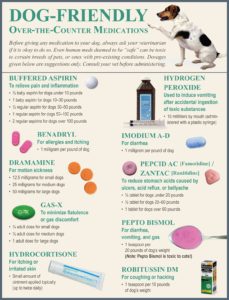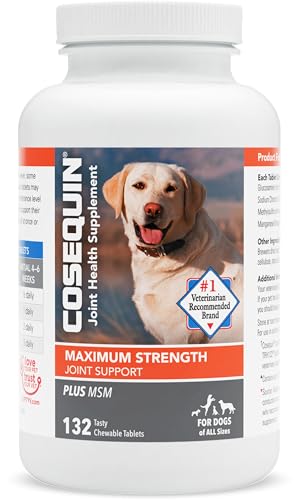You've noticed that your dog is limping, and suspect that it could be arthritis setting in. You are worried that the dog is in pain as your pooch eases their way into the bed and grunts as they get up slowly. You find yourself asking, what can I give my dog for pain?
Your first instinct may be to check your medicine cabinet to see what is available. Maybe you want to offer your dog an aspirin, or some other type of pain reliever that is meant for human consumption.
Do not do this, and call your veterinarian instead.
Human pain drugs like Tylenol, Ibuprofen or aspirin can kill a dog (1). Instead, there are dog pain medications that are safe for pets. Some of them them are available as over-the-counter, but the most strong ones will need to be prescribed by a veterinarian.
NSAID Pain Relief for Dogs
Depending on the cause of pain, your vet may prescribe NSAIDs (non-steroidal anti-inflammatory drugs). They are most commonly used pain relievers for dogs, and known brands include Rimadyl, Deracoxib, Metacam, Previcox and Piroxicam.
NSAIDs work by targeting an enzyme called cyclooxygenase (2). Cyclooxygenase, or COX, stimulates cells to produce a substance called prostaglandins, which are present throughout a dog's body. This substance contributes to pain, inflammation and fever.
When NSAIDs for dogs block cyclooxygenase, this reduces the amount of pain, fever and inflammation the dog is having (3). By blocking the enzyme COX, your dog’s body has less prostaglandins, and feels less pain. When seeking answers for “what can I give my dog for pain,” most pet owners will end up with NSAIDs.
FDA approved NSAIDs for dogs (4):
| Active Ingredient | Brand Names |
|---|---|
| Carprofen | It has many different brand names |
| Deracoxib | Deramaxx, Doxidyl (generic) |
| Firocoxib | Previcox |
| Grapiprant | Galliprant |
| Meloxicam | It has many different brand names |
| Robenacoxib | Onsior (3 day max use) |
Potential Risks of Using NSAIDs
NSAIDS have been widely studied and are generally considered safe for dogs, with only minor side effects (5, 6, 7). However, some studies were either poorly designed, or lacking in reporting of long-term safety (8). There's is also a growing concern over their use among veterinarians (9, 10, 11).
Before using any pain relievers, ask your vet about their stance on NSAIDs and specifically inquire about all the potential side effects. Make sure the vet is aware of most recent findings in scientific literature.
Your veterinarian should be aware of all the risks from NSAIDs as well as better alternatives. They will recommend an appropriate pain reliever and dose for your dog’s condition. It's crucial to follow dosage directions to a letter.
Note: If you're switching a dog from one NSAID to another, and there were no adverse reactions, a “washout” period is necessary: 5 to 7 day wait without any consumption of either drug before the new brand can be administered (12).
Signs of Adverse Reactions
Your dog is likely to get get good results from taking NSAIDs for pain relief. However, most of these drugs are not meant for long term use. They should be given with caution, and if consumed for more than a week, only under the supervision of a vet.
For example, between 2005 and 2010, 3% of cases received by ASPCA were related to NSAID incidents in dogs and cats, with a total number of incidents – 22,206 (13).
The most common offender in this and other cases was iboprofen (14). The others were aspirin, naproxen, deracoxib, meloxicam, diclofenac, piroxicam, indomethacin, nabumetone, and etodolac.
Most common reported side effects of NSAIDs for dogs include vomiting, diarrhea, lack of appetite and lethargy (15). Less common side effects include intestinal and stomach ulcers, intestinal and stomach perforations, liver and kidney failure, and even death (16).
As your dog starts taking NSAIDs, watch for signs of adverse reactions because not all dogs will tolerate these medications well. There is an easy way to remember what to look for in your pet when you remember that your dog is your B-E-S-T friend:
- Behavior changes
- Eating less
- Skin redness, scabs or hair loss
- Tarry stools, diarrhea or vomiting
If your dog starts to have any of these B-E-S-T symptoms while taking NSAIDS, or any medication, stop their use immediately and call your veterinarian.
Side effects from NSAIDs are more common when giving two different brands at the same time, or when pairing an NSAID with a steroid drug like prednisone. When these drugs block prostaglandins activity and/or fewer prostaglandins are made in a dog's body, the animal's whole digestive tract will be at risk of serious damage.
Prescription Pain Medications for Dogs
Your dog can have a more serious medical issue, which is when a vet would prescribe a much stronger prescription pain reliever instead of an NSAID.
For example, opioids and opiates could be recommended instead. This is a type of strong narcotic. These drugs work by completely blocking a dog’s ability to recognize pain. Many veterinarians do not like to prescribe these types of drugs due to stiff regulations by the DEA. Also, some oral opiates may not be effective enough while still harming a dog.
Some other dog pain relief options that your vet may discuss with you include:
- Amantadine – This is an anti-Parkinson’s drug for humans that helps to block pain. Dogs with serious conditions like cancer, disk disease, or degenerative arthritis may be prescribed this medication (17). Your veterinarian will have you watch for common side effects, which can include diarrhea and agitation.
- Gabapentin – Gabapentin, also known as Neurontin, is an anti-seizure and neuralgia medication for humans that can treat pain from damaged nerves in dogs (18). This medication requires close monitoring from your vet and can sometimes be prescribed in conjunction with other medications. One noticeable side effect is drowsiness, but this may go away once your pooch adjusts to the medication.
- Tramadol – While many veterinarians avoid most opiate medications, Tramadol is a painkiller that chemically works like a mild opioid medication while containing no actual opiates (19). It is still a somewhat strong painkiller that can also have side effects. Tramadol for dogs is given to control constant pain and discomfort, particularly in aging dogs. However, some studies found it ineffective/too weak for pain (20).
Dog Supplements for Pain
For minor pain issues in dogs, you can also try nutraceuticals and dietary supplements if you want to avoid the use of chemical drugs.
Alternative treatments are often a first choice for some dog owners, because they wish to avoid unnecessary side effects from stronger prescription medications. However, most studies show them to be fairly ineffective for pain, particularly for serious medical conditions like osteoarthritis (21, 22).
A few nutraceuticals, however, did show positive results (23, 24). For example, two popular supplements for arthritis pain are glucosamine and chondroitin. They work over time by helping the body heal and repair cartilage, which also reduces swelling.
Supplementing your dog’s food with extra omega-3 fatty acids that also contain enough of eicosapentanoic acid (EPA) may work to reduce joint inflammation and pain. Fish oil supplements will typically contain a good dosage for dogs.
Some of the best supplements for arthritic pain in dogs include:
| Preview | Product | Rating | |
|---|---|---|---|

|
Doggie Dailies Glucosamine for Dogs - 225 Chews -... | 26,532 Reviews | Check Price |

|
Nutramax Laboratories Cosequin Maximum Strength... | 65,311 Reviews | Check Price |

|
Zesty Paws Omega 3 Alaskan Fish Oil Chew Treats... | 12,205 Reviews | Check Price |

|
Grizzly Pollock Oil Supplement for Dogs, 64-Ounce | 1,726 Reviews | Check Price |
Summary
It's very likely your dog will experience pain at some point in their life. Most commonly, the pain is associated with joint problems and arthritis in senior dogs. There are several pain relief options available – from less effective but natural remedies, to nutraceuticals and supplements, to NSAIDs and opioids.
Avoid giving your dog human pain medication and discuss safer drugs with your veterinarian. If your vet prescribes an non-steroidal anti-inflammatory drug, ask them about all the potential side effects, because they are more common than with less stronger medications.
For dogs with arthritis, dietary changes and supplementing your pet's meals with omega-3 fatty acids, glucosamine and chondroitin can also be very beneficial and ease their pain.
READ NEXT: The Ultimate Guide On Pain Management for Dogs
Disclosure: We may earn affiliate commissions at no cost to you from the links on this page. This did not affect our assessment of products. Read more here and find full disclosure here.















